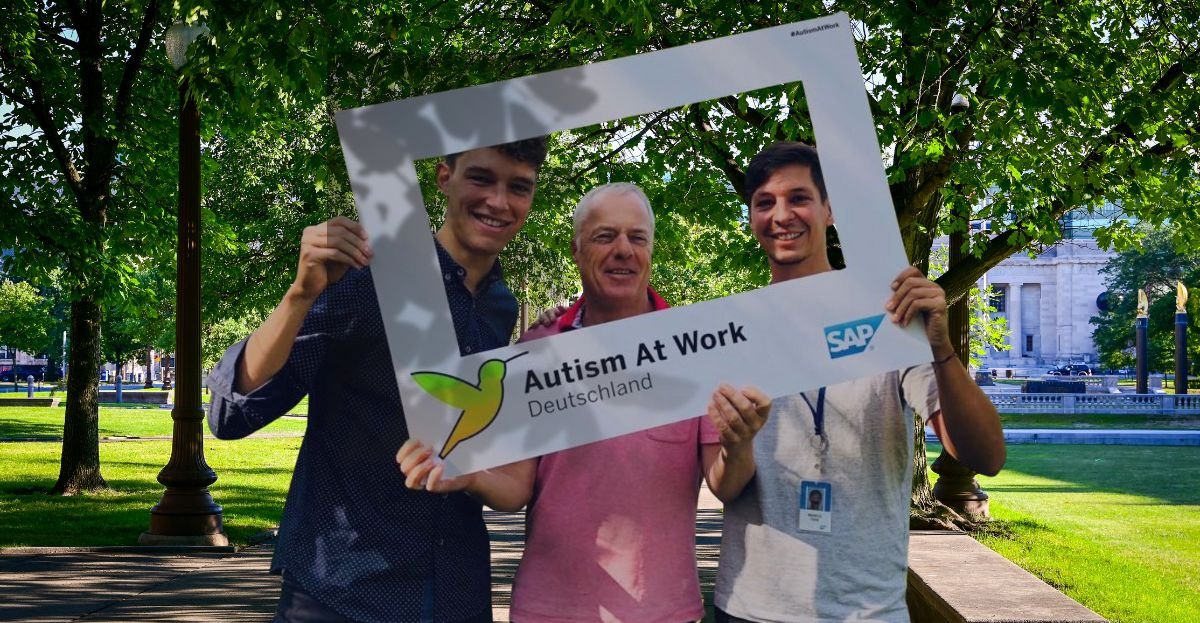Image Source: Embracedifference.ert.eu
Introduction to SAP’s Autism at Work Program
Since 2013, SAP’s Autism at Work program has aimed to shift inclusion—from accommodating people with autism to hiring because of the unique strengths they bring. These strengths include exceptional pattern‑recognition, attention to detail, and consistency—critical for software testing, data analysis, and cybersecurity tasks.
History and Global Rollout
Kick‑started in 2013, SAP partnered with Specialisterne, a Danish inclusion specialist, to develop a neuroinclusion hiring program . India was among the first pilot locations, where SAP Labs India collaborated with Specialisterne and NGOs to recruit candidates for roles like software testing SAP set an ambitious target: neuroinclusive hiring should reach at least 1% of its workforce by 2020.
Key Objectives and Commitments
SAP’s goals are clear: not just diversity but neuro‑inclusion at every level, with the ambition that employees on the autism spectrum represent no less than 1% of global headcount . The company integrates this focus into its wider D&I strategy, alongside gender, culture, and generational diversity.
Program Structure and Support Mechanisms
The Autism at Work program features:
-
Special hiring practices—automation in interviewing, provision of questions beforehand, focus on skills over social nuance
-
Mentors and job coaches, often from local partner NGOs, to ease transitions and support social integration.
-
Onboarding accommodations: dedicated buddies, structured meetings, awareness sessions to guide managers and colleagues.
Roles and Contributions of Autistic Employees
SAP employs individuals on the spectrum in both tech and non‑tech roles – from finance and HR to cybersecurity and software development . For example, finance colleague Nico Neumann automated invoice posting processes, reducing manual work from days to minutes and earning an internal innovation award.
Measurable Impact and Achievements
-
Today, SAP has over 215 neurodiverse employees in 16 countries .
-
Retention rates are about 90%, significantly higher compared to average corporate retention .
-
Teams report enhanced team cohesion, clearer communication, and enriched workplace culture.
Personal Stories and Testimonials
Sascha Dietsch, diagnosed before starting at SAP, later became a cyber‑security professional after seeing role models during Autism at Work events. He said, “I do not have to mask myself”, highlighting authentic belonging and supportive hiring .
Cultural and Operational Shifts
SAP transformed its work environments and culture by:
-
Installing sensory-friendly lounges and “tranquility rooms” at events and offices.
-
Training managers in clear feedback methods—making implicit expectations explicit.
These adjustments benefit all employees, promoting psychological safety and well-being .
Ecosystem Engagement: Pledges and Partnerships
SAP’s Autism Inclusion Pledge encourages other organizations to adopt similar practices. Over 100 companies and partners have signed on. Partnerships with NGOs, peers, governments, and forums foster shared best practices.
Awards and Recognition
SAP’s Autism at Work program has not only delivered internal success but also garnered prestigious external recognition, affirming its role as a global leader in neurodiversity hiring.
In 2023, SAP received the Corporate Compassion Award from the HollyRod Foundation, an organization dedicated to providing support to individuals living with autism and Parkinson’s disease. This award recognized SAP’s pioneering work in building inclusive workplaces that empower individuals on the spectrum to thrive, rather than merely be accommodated.
Moreover, SAP played a critical role as the sponsor of Disability:IN’s Autism Inclusion Company of the Year Award in 2023. Disability:IN is a global nonprofit that works with corporations to achieve disability inclusion and equality. Through this sponsorship, SAP not only amplified its own commitment but also actively encouraged other companies to adopt similar inclusion models.
Beyond formal awards, SAP has received widespread recognition in:
-
Global Media: Outlets like Forbes, The Financial Times, and Harvard Business Review have spotlighted SAP’s program as a best-in-class example of neurodiversity hiring done right.
-
Industry Conferences: SAP leaders are regularly invited to share their learnings at HR tech events, inclusion summits, and neurodiversity panels globally.
-
Peer Acknowledgment: Other corporate giants, including Microsoft, JPMorgan Chase, and EY, have credited SAP with inspiring their own neurodiversity hiring initiatives.
These accolades and visibility not only validate SAP’s approach but also help normalize conversations around autism in professional environments, reducing stigma and promoting systemic change.
Lessons Learned & Best Practices
Over a decade of running Autism at Work has taught SAP that genuine inclusion requires continuous learning and adaptation, not just good intentions.
Key Lessons:
-
Make the Implicit, Explicit
Many traditional workplace practices rely on unwritten rules and unspoken social cues. For individuals on the spectrum, these “invisible” expectations can be barriers to success. SAP ensures:-
Clear, written job expectations
-
Direct feedback channels
-
Structured project timelines
-
-
Individualization Over Standardization
No two autistic individuals are alike. SAP learned to avoid a “one-size-fits-all” approach by:Related Posts
-
Providing personalized work environments
-
Offering flexible work arrangements (remote, hybrid)
-
Adapting sensory-friendly spaces to individual preferences
-
-
Managerial Training is Crucial
A manager’s understanding can make or break inclusion efforts. SAP’s success stems from:-
Mandatory manager awareness programs
-
Peer learning sessions to share practical insights
-
Building psychological safety within teams
-
-
Inclusive Design Benefits Everyone
Interestingly, accommodations designed for autistic employees often improved the workplace for all:-
Quiet rooms reduced burnout for all employees
-
Clearer communication practices improved team performance
-
Flexibility and transparency boosted overall engagement
-
-
Partnerships Strengthen Outcomes
SAP’s collaborations with organizations like Specialisterne, Autism Speaks, and local NGOs have been instrumental in:-
Identifying qualified candidates
-
Providing ongoing coaching and mentoring
-
Advocating for broader policy change
-
These lessons are not static. SAP continues to refine its program based on employee feedback, evolving workplace trends, and scientific insights into neurodiversity.
Industry Impact and Broader Trends
SAP’s Autism at Work program has had a catalytic effect on the global business landscape, accelerating a shift towards neurodiversity inclusion far beyond its own offices.
Ripple Effects Across Industries:
-
Tech Sector: Inspired by SAP, companies like Microsoft, Salesforce, and Dell have launched their own autism hiring initiatives. These programs target roles in software testing, cybersecurity, and AI—fields where attention to detail and pattern recognition are invaluable.
-
Banking & Finance: JPMorgan Chase’s “Autism at Work” program, influenced by SAP, has hired hundreds of neurodiverse employees in data analysis and operations roles, reporting increased productivity and reduced turnover.
-
Pharmaceuticals & Healthcare: Companies like Pfizer and Novartis are exploring autism hiring in areas like clinical data management and medical research, where systematic thinking and precision are essential.
-
Retail & Consumer Goods: Neurodiversity hiring is expanding to customer service, logistics, and quality control, as organizations recognize the unique skills autistic individuals bring beyond technical fields.
Policy and Advocacy Influence:
SAP’s leadership in neurodiversity has also shaped public policy and industry standards:
-
The company actively contributes to discussions on disability inclusion at the World Economic Forum.
-
It has supported the development of global frameworks for inclusive hiring under organizations like Disability:IN.
-
SAP’s Autism Inclusion Pledge has encouraged over 100 companies worldwide to commit to neurodiversity-friendly practices.
The Broader Trend:
SAP’s success underscores a critical workplace evolution – from simply “accommodating” autistic employees to actively harnessing their strengths for innovation, problem-solving, and improved business performance.
This trend is no longer confined to early adopters. Neurodiversity is becoming a mainstream diversity pillar, alongside gender, cultural, and generational diversity initiatives.
Conclusion
SAP’s Autism at Work program is not just an HR initiative – it’s a blueprint for how companies can unlock the untapped potential of neurodiverse talent to drive innovation, productivity, and cultural transformation.
By focusing on authentic inclusion – not tokenism – SAP has shown the world that business success and social impact are not mutually exclusive. Its measurable results – higher retention, improved processes, global awards, and industry influence—prove that neurodiversity is a competitive advantage.
For organizations striving to be truly amazing workplaces, SAP’s journey offers a powerful lesson: when you design work for all minds, you create environments where everyone – regardless of cognitive style – can do their best work.
Frequently Asked Questions
Q1: What roles do autistic colleagues fill at SAP?
A: Roles span HR, finance, cybersecurity, software development, testing, and operations—across tech & non-tech fields .
Q2: How many autistic employees does SAP have?
A: Over 215 in 16 countries as of mid-2023 .
Q3: What support does SAP offer new hires?
A: Customized hiring, advance interview prep, sensory-friendly spaces, and dedicated mentors/job coaches .
Q4: What measurable impact has the program shown?
A: ~90% retention, increased team cohesion, faster invoice processing, internal awards, and global recognition .
Q5: How does SAP influence other companies?
A: Through Autism Inclusion Pledge (>100 signatories), speaking events, and sponsorship of Disability:IN awards .
Q6: Can SAP’s model apply outside tech?
A: Yes -banks, retail, pharma, and public sectors are adopting neuroinclusive hiring and accommodations .










